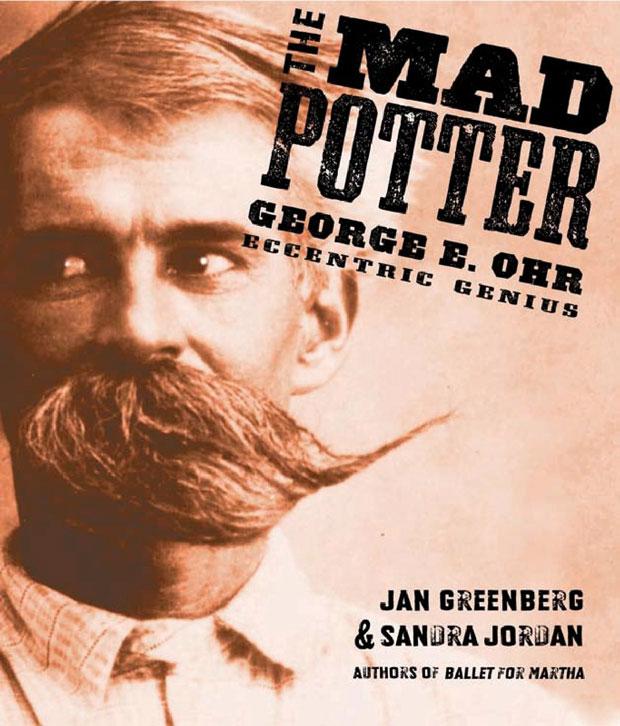St. Louis writer explores life of ‘The Mad Potter’
Published May 14, 2014
The naturalistic talent of an almost undiscovered artisan is explored in the latest literary collaboration of St. Louisan Jan Greenberg and New Yorker Sandra Jordan. Their book, “The Mad Potter: George E. Ohr, Eccentric Genius” (Roaring Brook Press, N.Y., $17.95.), has been named a Robert E. Siebert Honor Book.
Greenberg, 70, is no stranger to St. Louis readers. A resident of Clayton, Greenberg has published 22 books of fiction and nonfiction for children and young readers, in addition to numerous short stories and articles. Her book reviews have appeared in the St. Louis Post-Dispatch and The New York Times.
Her most recent book with Jordan was “Ballet for Martha: Making Appalachian Spring,” which earned numerous awards, including the prestigious NCTE Orbis Pictus Award for outstanding nonfiction for children. Some of her other books include: “Andy Warhol, Prince of Pop,” “Action Jackson,” “Just the Two of Us,” “The Pig-Out Blues,” “Vincent Van Gogh: Portrait of an Artist” and “Runaway Girl: The Artist Louise.”
The Jewish Light caught up with Greenberg to talk about “The Mad Potter,” among other projects.
Who was George E. Ohr and how was his artistic genius discovered?
“The Mad Potter: George E. Ohr, Eccentric Genius” is the story of an American maverick, an artist/ceramacist, whose body of work was hidden away in crates on his sons’ property in Biloxi, Miss., until he was rediscovered 50 years after his 1918 death. He is now considered one of America’s greatest potters.
What sets Ohr apart from other potters?
A flamboyant character whose quirky, abstract pots didn’t fit in with conventional tastes, George always believed his work was “unequaled, unrivaled and undisputed.”Sandra Jordan and I had a wonderful time researching and putting this book together, as we loved his art, poetry and his wild personality.
What challenges did you face in telling Ohr’s story?
Not only digging up vintage photographs of George and the South at the turn of the century, but also making sure that our young readers could place him in the context of his times.
So what drew you and Jordan to this project?
Back in the 1980s, an art dealer in Los Angeles invited me over to see his collection of pottery by an artist named George Ohr, who had died in obscurity in Biloxi in 1918. “Ohr called himself ‘The Mad Potter,’ ” my friend told me. “The ceramics establishment thought his personality, as well as his pottery, were too flamboyant. He was ahead of his time.”
Did you have an existing interest in pottery before you took on this project?
Fascinated by the Arts and Crafts movement, I had started my own modest collection of green matte pottery from that era, which I found at various flea markets, antique malls and junk stores. But I’d never seen anything quite like the crinkled, wrinkled, distorted, abstract pots by George Ohr that lined the shelves of this man’s study. I ended up buying a small mug with a metallic glaze and a whimsical snake wrapped around it.
Did Jordan share your interest in this kind of pottery?
When Sandra Jordan and I began writing books together, we often took breaks by going on what we called field trips – museums, galleries, movies, plays, bookstores, gardens, restaurants, even a party or two constituted these forays away from the computer. … In Lambertville, N.J.,after a presentation at a children’s literature festival, we stopped in David Rago’s gallery and discovered we both admired George Ohr’s pottery.
So did you immediately take on the project of writing this book?
The years went by, as we wrote 12 books on the arts and settled into a collaborative that sometimes makes us behave like an old married couple. At a conference in New Orleans several years ago, a field trip in and of itself, we had a free day between an award ceremony and a panel and decided to drive to nearby Biloxi, where the architect Frank Gehry (we’d written a book about him) had designed a museum in honor of George Ohr. It had been leveled in 2005 by a gambling barge that had been lifted off its moorings during Hurricane Katrina. The Gehry museum buildings were finally being rebuilt. We’d been invited for a hard-hat tour. There we discovered through vintage photographs and reference books that not only were George Ohr’s pots wild and interesting, but so was his life.
Is it your hope that this book will finally give George Ohr the recognition he has long deserved?
Now “The Mad Potter” is out, and people are saying, “Who is George Ohr?” In our books for children, we’re not writing about famous historical figures like George Washington or the pharaohs of Egypt. We’re dealing with people kids might be seeing for the first time. This challenges you to make it interesting. We ask ourselves, “Is this a good story? Is it visually compelling?”
Do you feel you accomplished your goal?
This is a tale of redemption for an artist, George Ohr, who, like Van Gogh, believed passionately in his own talent, worked hard and finally received the recognition he deserved. I always understood how George felt when he discovered the potter’s wheel, because that’s how I felt when I started my first novel. It wasn’t at all like my fantasies. It was better than that.















